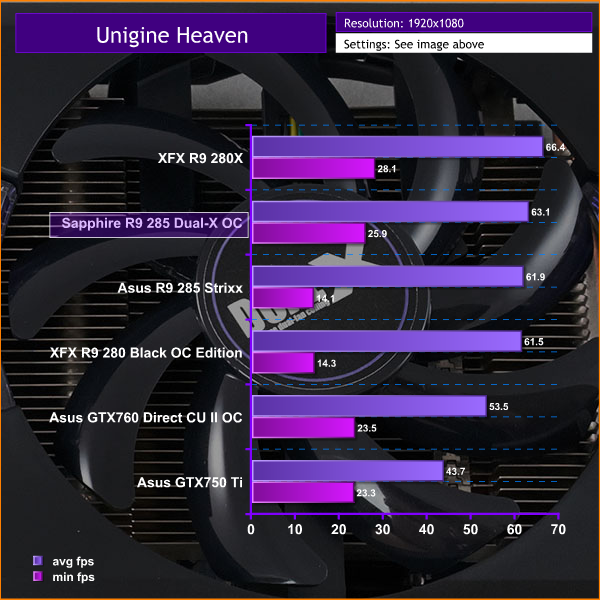Unigine provides an interesting way to test hardware. It can be easily adapted to various projects due to its elaborated software design and flexible toolset.
A lot of their customers claim that they have never seen such extremely-effective code, which is so easy to understand.
Heaven Benchmark is a DirectX 11 GPU benchmark based on advanced Unigine engine from Unigine Corp. It reveals the enchanting magic of floating islands with a tiny village hidden in the cloudy skies. Interactive mode provides emerging experience of exploring the intricate world of steampunk.
Efficient and well-architected framework makes Unigine highly scalable:
- Multiple API (DirectX 9 / DirectX 10 / DirectX 11 / OpenGL) render
- Cross-platform: MS Windows (XP, Vista, Windows 7) / Linux
- Full support of 32bit and 64bit systems
- Multicore CPU support
- Little / big endian support (ready for game consoles)
- Powerful C++ API
- Comprehensive performance profiling system
- Flexible XML-based data structures

We switched Tessellation to ‘normal’ and quality to ‘high’, running at 1080p resolution.


Solid frame rates, averaging just over 63 frames per second. We didn't notice the same microstuttering we experienced with the ASUS card between a couple of tests – as indicated in the minimum frame rate result.
 KitGuru KitGuru.net – Tech News | Hardware News | Hardware Reviews | IOS | Mobile | Gaming | Graphics Cards
KitGuru KitGuru.net – Tech News | Hardware News | Hardware Reviews | IOS | Mobile | Gaming | Graphics Cards



I agree with what was said on the pricing. Why buy this right now when you can get good deals on R9 280s?
It’s a replacement for the 280…so the price diff will only last as long as the 280s last.
Hmm, the KitGuru noise guide is a bit low on the decibels. And holy crap, I just realized how energy efficient the 750 ti is compared to its sadly low power :/ If only all cards wasted that few watts 🙁
This is a clear and concise review one of the best I’ve come across. Your use of similarly OC AIB customs leaves the reader not conjecturing like so many that went reference 760’s.
The 285 is a fine substitution for the 280, and while there’s still great deals on a lot of the 280’s, yes you’d have to quandary in which to go with. If your one to kind of think of a C-F in the near term, I’d say a 285 as it including CrossFire XDMA might make a strong contention (like to see C-F 280’s vs. 285’s). I think if I recognized I wasn’t predicting a monitor upgrade (1440p) during the life of the card, the choice of improved tessellation performance, along with it quad-shader layout, allowing four primitives to be rendered per clock cycle instead of two might be more useful as more titles evolve. Lower power is good, while I don’t see the whole memory @1080p add any apprehension.
It’s a hard call on the AMD side between (they win either way)… but consigns the 760 as no longer any smart deal. Then with Nvidia saying “nothing” as to its’ pricing, while bring it’s big brother into the fight with its price drop, one can pretty much figure Nvidia will let the 760 go quietly into the night.
Look at the 750Ti as the “5670” for the mainstream resolution today, just as the 5670 the no aux-power choice when 1680×1050 was in vogue. Given @1080p with the setting at medium is more its place to keep from “slide show” Fps, judging it in with this group is frivolous. Look at similarly OC customs of a 750Ti and 260X when gaming, the 260X needs 20% more while neither offer any difference in settings or immersion.
It’s nice to save power during 2-3 hours of gaming, but if you sleep (monitor off) AMD ZeroCore drops to 2-3W, while the 750Ti draws 5-7W when no one is using it perhaps 18 hours a day! If you really look at the total efficiency over a month’s power usage that saving is not all that pronounced.